| Article ID | Journal | Published Year | Pages | File Type |
|---|---|---|---|---|
| 62995 | Journal of Catalysis | 2006 | 11 Pages |
CeO2 and La- or Pr-doped CeO2 were prepared at calcination temperatures of 600, 800, and 1000 °C. The samples were characterized by Raman, XRD, and N2 adsorption and tested as Rh2O3 support for the catalytic decomposition of N2O at low temperature (starting at 200 °C). Catalyst characterization was done by XPS analysis of fresh and in situ treated catalysts, TPR, and TEM. As deduced by XPS analysis and catalytic tests, Rh2O3 is more active than Rh0 for N2O decomposition. Pure CeO2 calcined at low temperature (600 °C) and La or Pr-doped CeO2 calcined at 600, 800 or 1000 °C can keep Rh2O3 stable under reaction conditions. In contrast, Rh2O3 supported on pure CeO2 calcined at high temperature (800 or 1000 °C) is reduced to Rh0 under reaction conditions. The redox properties of the support are decisive for Rh2O3 stabilization and catalytic performance; the larger the reducible surface CeO2 (determined by TPR), the better the catalytic activity. In addition, structural and textural features of the support (crystallinity, BET surface area, and particle size) affect Rh2O3 dispersion, the smaller the support particle size (the higher the surface area), the better the dispersion and the catalytic activity. The redox properties and particle size of supports depend on calcination temperature. Doping improves thermal stability with regard to pure CeO2. La and Pr form solid solutions with CeO2, preventing sintering and maintaining a high percentage of reducible CeO2 at high calcination temperatures (800 and 1000 °C).
